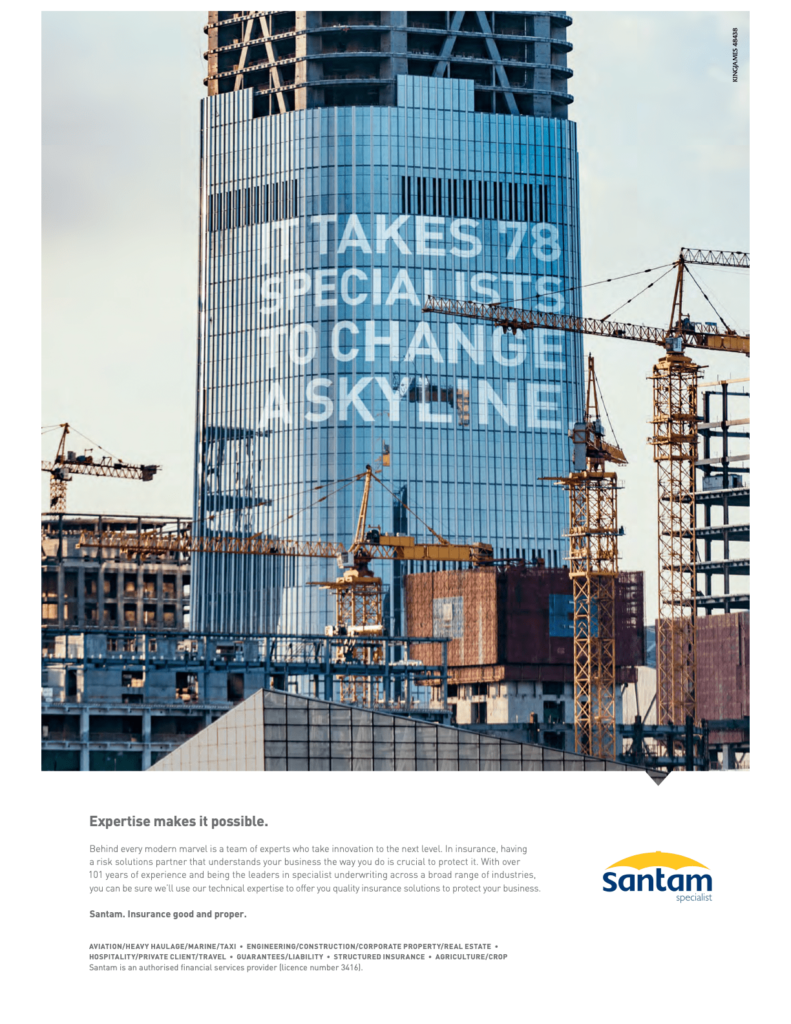James Godden, Head of Santam Aviation
As is the case with virtually every facet of the global transport industry, the South African aviation sector has not been exempt from the effects of the COVID-19 pandemic.
Aircraft operators across all disciplines are currently fighting for financial survival in the wake of the global health crisis.
The Covid-19 lockdown restrictions saw 80% of its aircraft clients grounded between April and August 2020, resulting in an average loss of 60% in income during that time.
In an environment already heavily dictated to by legislation and compliance, it is now more critical than ever that industry role-players look at partnership-driven solutions to reduce financial stress on aircraft operators in an urgent bid to get the sector off the ground again.
As the largest and most experienced specialist aviation insurer in Southern Africa, Santam Aviation currently insures 4000 plus registered aircraft, which comprise R130-million of South Africa’s annual R500-million aviation insurance premiums. This includes private and corporate, recreational, aerobatic, agriculture, charters, surveillance and tracking related aircraft.
It has been an intense period with the introduction of Covid-19 negation measures that have introduced changes to normal operating procedures. At Santam Aviation we’re focused on doing everything possible to support clients through these uncertain times while providing the right type of security to support their investment.
With the strict lockdown measures that saw the grounding of all aircraft in March last year, Santam Aviation immediately responded by switching its aviation clients to ground insurance cover in an effort to alleviate the financial pressure during the hard lockdown period.
But aircraft that have been grounded for such an extended period of time presents a different set of challenges altogether. Grounded aircraft are vulnerable to rust damage from being inactive, and aircraft parts have a variable lifespan. This puts further pressure on maintenance obligations.
Clearly, this is a no-win situation for our clients – and something that has undoubtedly contributed to the biggest issue for the industry this year. Already by April this year, half of the country’s total aviation premiums have already been under claim. This has the potential to translate into rate increases to cover losses – something we ideally want to avoid.
We have seen a massive spike in aircraft insurance claims, with around R250-million in claims in the first quarter of 2021 alone. What is interesting is that 90% of claims are related to pilot error, particularly in relation to take-offs and landings.
The team at Santam Aviation, along with industry partners, is actively looking into the possible contributing factors in order to consider the motivation for the introduction of conditional terms in insurance cover going forward.
We need to assess if these factors can be attributed to the impact of Covid-19. For example, with pilots not being able to fly their mandated hours, there could be a condition forcing them to return to flying school to complete a certain number of take-offs and landings with an instructor.
It is clear that the South African aviation industry has a very unique risk profile and complex insurance requirements that require a highly knowledgeable underwriting skillset.
Typically an insurer’s primary focus is to protect its client’s assets and to pay out in the unfortunate event that something does go wrong. However, when it comes to aviation insurance, it is important to realise that a specialist aviation insurer is equipped to offer insights into, and help guide clients through the vast range of factors and regulatory requirements that influence the market.
For the past 40 years, Santam Aviation has developed a solid understanding of the changing risk environment, aircraft and aviation laws and safety and security compliance requirements that guide the South African aviation industry. These key differentiators also underpin Santam Aviation’s offering in the 33 continental nations in which it operates.
This particular skill set and in-depth market knowledge is crucial when it comes to the aviation industry in the rest of Africa, where exchange controls and securing premiums is trickier. Despite these challenges, Santam Aviation considers Africa a key growth market for the business, particularly the eastern regions and South Africa’s neighbouring territories.
Even submitting an aviation insurance claim could be an intricate matter. Submitting a claim in contravention of law, or without the required certifications, could have dire consequences – which may be financially crippling to the policyholder.
Even a usually straightforward claim like damage caused by taxi-ing into a runway hole or clipping a hangar door will be rejected if the paperwork is not in order. Obviously, the impacts are devastating if there is a loss of life, more so if the deceased are related to or known to the owner/pilot.
The most basic of cover, and which is dictated by law, is third party/passenger insurance, but the greatest liability is when the aircraft is in motion, which requires a comprehensive cover. That premium is variable dependent on the risk exposure, such as the purpose of the flight; the level, age and experience of the pilot; the type of aircraft; the area of operation, among others.
It is clear that the business of aviation insurance is complex. Aviation has suffered and will continue to struggle until the pandemic is under better control. For insurers, those immediate opportunities lie in developing a sustainable long-term approach and supporting aviation clients as the sector limps through the crisis.
It is absolutely critical that role-players find joint solutions and drive a collective approach to ensure the survival and longevity of an entire industry.


